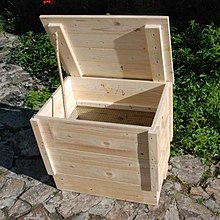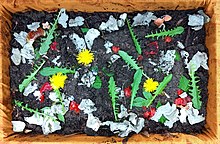Worm composting
Worm composting refers to targeted composting with compost worms , while a worm farm aims to multiply the worms for use as its goal. The finished compost, the worm droppings or extracts from it, the worm tea , are sold as organic fertilizer , the worms as bait for fishing and as fish feed .
Composting plants
There are very large professional vermicomposting plants that specifically aim for faster composting. These are operated in Canada , Italy , Japan , the Philippines and the USA , for example . Extensive scientific studies are available on the activities of earthworms .
Composting plants for household use
Small worm composters are primarily used to recycle organic kitchen scraps that arise in the household. The advantage of these containers is the low space and maintenance requirements. They can also be operated on balconies or in vestibules if necessary. With proper care, composting is almost odorless and the compost material does not need to be moved.
Medium sized worm composters are usually set up outdoors; These are special rents that can have an area of around 10 m².
features
The community in a worm composter corresponds roughly to that of a compost heap . These include bacteria, fungi and other decomposers of Edaphons such as various protozoa , springtails , some soil mites , small white segmented worms from the family of white worms and compost worms - for example, the species Eisenia foetida , Eisenia andrei and Dendrobena Veneta (also known as Eisenia hortensis known ). This community produces worm humus , a natural product with highly concentrated components of plant-available nutrients.
In a worm-composter, the number of individuals per cubic meter of these soil animals is many times higher than in the garden, as optimal living conditions prevail in it all year round. The following requirements are required for this:
- The worm composter content must be kept moist at all times, as all compost inhabitants depend on sufficient moisture and - in the case of microorganisms - can only move in a film of water.
- An optimal working temperature; this is around 20 ° C, which roughly corresponds to the room temperature in apartments. The compost inhabitants are most active in this cold rot . Temperatures below 0 ° C or above 30 ° C are fatal to organisms in the long term.
- Under no circumstances should the pH drop below 6.5. Otherwise the environment will be too acidic, which can be harmful to the worms. For this reason, sour fruit (for example leftover oranges , lemons and rhubarb ) is not fed.
- Plants containing pesticides , fungicides and herbicides (waste) or waste with chemicals with a biocidal effect should not be fed.
Care and use
Maintaining a worm composter is pretty easy and hardly time consuming. The fresh organic kitchen scraps such as fruit , vegetables , coffee grounds and organic small animal litter are shredded and moistened before they are placed in the composter. For reasons of hygiene , it should be avoided to compost cooked leftover food, meat, fish and used cat litter or pet excrement in this way.
A damp and wet hemp or felt mat that covers the entire contents of the box is helpful; it keeps fruit flies away and prevents the fresh food from drying out superficially as well as the formation of mold . In addition to this measure, the surface of the material to be composted can also be covered with a thin layer of earth, which offers additional protection. In a worm-composter, moistened paper or cardboard can also be fed, but these materials must be free of heavy metals (for color prints).
Since the kitchen leftovers mainly consist of well-rotting nitrogen and water-containing plant remains, their composting is associated with a strong reduction in volume. On average, every 10 liters of kitchen waste leaves around 1.5 to 2 liters of worm humus.
Since the vermicomposting is completely aerobic , there are no unpleasant putrid smells .
Types of worm composters
Level composter
Level composters are often found in stores. These usually consist of a container for the seepage liquid that accumulates during the composting process, and several removable levels (often three). The levels of the vessels fit into each other and gradually fill with compostable substances. The bottom of the individual layers has holes so that the worms can move from one level to the other, to come up from a lower level to the fresh feed or to escape overheating of the compost above, to the eradicated part below. Compost worms spend most of their time in the top 5 to 10 cm; so the bottom level of the composter with the finished worm humus can be removed when the top level is full.
Due to the identical levels, a continuous removal of the worm humus on the one hand and the addition of compostable waste on the other hand can be guaranteed. The top level is used for filling with compostable waste. As soon as this is full, the lowest level, which is now full of worm humus, is removed, emptied and placed on the filled level; it can be refilled with compostable waste. Since the worms migrate to the fresh waste as soon as they have completely decomposed the waste in one level, the lowest level is almost worm-free when it is removed. The liquid can also be drained from the collecting container and used as liquid fertilizer.
Worm box
The worm box is usually a completely closed box made of untreated, breathable wood, as this ensures the oxygen supply to the box contents.
In addition to producing compost, worm boxes are also suitable for use in environmental education . Equipped with a viewing window, the worm box opens up the possibility of directly observing the otherwise hidden processes of composting and humus formation. You can also watch the small soil creatures at work, which is an experience especially for children.
To extract the worm humus, it is not absolutely necessary to separate the worm box into two chambers using a perforated plate. A best practice is to:
- At the beginning, the entire box area is used
- if the box is almost half full after a while, the contents are heaped on one side
- From now on, only the fresh kitchen leftovers are entered on the vacated page; the compost worms and their helpers get their food in the new half
- if this half has also grown, half of it is left to dry out with ripe worm humus, with the result that after a while most of the living beings have changed sides.
- The ripe worm humus can now be “harvested” without sifting it and removing the compost worms from it.
The box must be dry and also have a cover against light, as UV radiation is harmful to earthworms.
Flat composting with compost worms
Aerobic flat composting with compost worms is suitable for converting large amounts of organic material (e.g. horse manure) into worm humus. The compost material is applied over a large area and thinly so that the compost worms can process the material before a thermophilic reaction occurs. This way, there are no odors. Flat composting is mostly an open space system. This type of worm composting is often used in connection with permaculture. The systems are about 60 cm deep and sealed with wood and wire against predators (for example voles, moles or birds). A depth of the compost to protect against frost is important so that the dungworms do not freeze to death in winter. The walls of plants for flat composting usually consist of wooden or concrete panels. Most garden waste is composted in such systems, but often horse, cow or rabbit manure is also composted. The surface is usually covered with straw or cardboard, since compost worms need darkness for optimal reproduction and UV light can lead to their death. Up to 8000 worms can sometimes live in one square meter.
further reading
- Walter Buch: The earthworm in the garden. Ulmer, Stuttgart 1986, ISBN 3-8001-6276-8 .
- Jasper Rimpau: Compost from the box. Ulmer, Stuttgart 2013, ISBN 978-3-8001-7976-3 .
- Andrea Heistinger, Alfred Grand: Make organic fertilizers yourself. Löwenzahn, Innsbruck 2014, ISBN 978-3-7066-2519-7 .
- Wendy Vincent: The complete guide to working with worms. Atlantic Publishing Group, 2015, ISBN 978-1-62023-010-7 . (English)
- Clive A. Edwards, Norman Q. Arancon, Ronda Sherman: Vermiculture technology. Earthworms, Organic Wastes, and Environmental Management. CRC Press, Boca Raton 2011, ISBN 978-1-4398-0987-7 . (English)
- CA Edwards: The use of earthworms in the breakdown and management of organic wastes. In: CA Edwards (Ed.): Earthworm Ecology. CRC Press, Boca Raton 1998, ISBN 1-884015-74-3 , pp. 327-354. (English)
- A. Asha, AK Tripathi, P. Soni: Vermicomposting: A Better Option for Organic Solid Waste Management. In: J Hum Ecol. 24, 2008, pp. 59-64. (English)
- JR Banu, S. Logakanthi, GS Vijayalakshmi: Biomanagement of paper mill sludge using an indigenous (Lampito mauritii) and two exotic (Eudrilus eugineae and Eisenia foetida) earthworms. In: J Environ Biol. 22, 2001, pp. 181-185. (English)
- B. Gunadi, C. Blount, CA Edward: The growth and fecundity of Eisenia foetida (Savigny) in cattle solids pre-composted for different periods. In: Pedobiologia. 46, 2002, pp. 15-23. (English)
- R. Riffaldi, R. Levi-Minzi: Osservazioni preliminari sul ruolo dell Eisenia foetida nell'umificazione del letame. In: Agrochimica. 27, 1983, pp. 271-274. (Italian)
- C. Lazcano, M. Gomez-Brandon, J. Dominguez: Comparison of the effectiveness of composting and vermicomposting for the biological stabilization of cattle manure. In: Chemosphere. 72, 2008, pp. 1013-1019. (English)
Web links
Individual evidence
- ↑ Vermicomposting: A Better Option for Organic Solid Waste Management. (PDF; 56 kB) Accessed February 21, 2009 .
- ↑ J. Pathma, N. Sakthivel: Microbial diversity of vermicompost bacteria that exhibit useful agricultural traits and waste management potential. In: SpringerPlus. Volume 1, 2012, p. 26, doi: 10.1186 / 2193-1801-1-26 . PMID 23961356 , PMC 3725894 (free full text).



